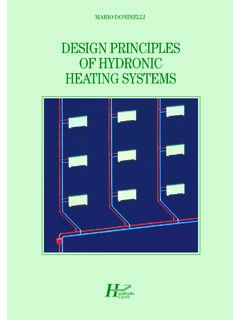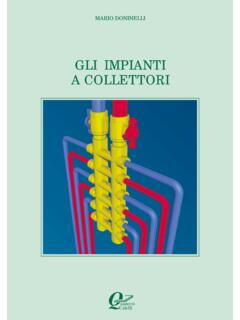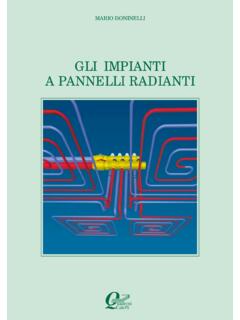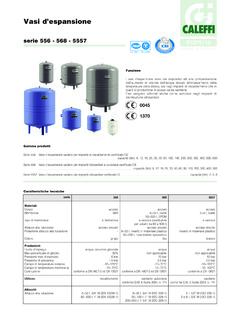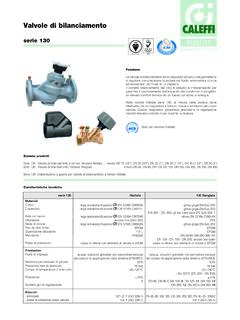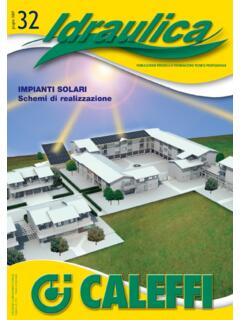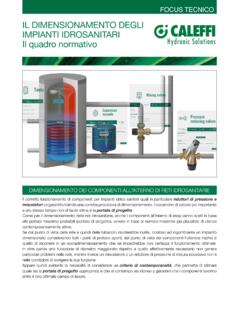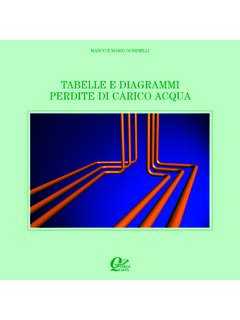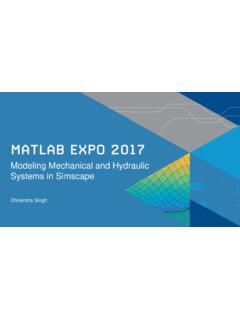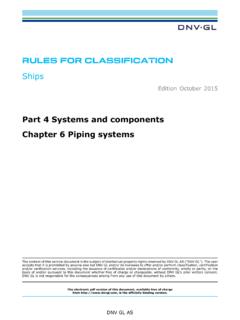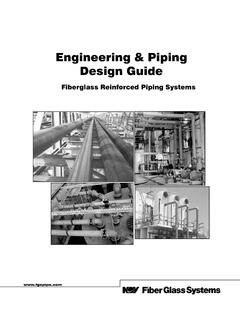Transcription of Beyond Primary / Secondary Piping - Caleffi
1 This Webinar is exclusively sponsored and the property of Caleffi Hydronic Solutions. All rights reserved. October 2007 hydraulic SeparationBeyond Primary / Secondary PipingpresentsModern compact boilers have much higher flow resistance than cast iron boilers. condensing/ modulating boilerzoned distribution systemIf they are simply substituted for cast iron boiler problems are likely to develop, most notably interference between simultaneously operating solution to this problem is hydraulic separation. In short, preventing flow in one circuit from interfering with flow in another systems with hydraulic separation the designer can now think of each circuit as a stand-alone entity.
2 Simplifying system analysis Preventing flow interferenceDclosely spaced teesmaximum 4xDflowprimary loopsecondary circuitsecondary circulatorprimary circulatorflow-check valveHydraulic separation is a new term to hydronic system designers in North / Secondary Piping , using closely spaced tees, is the best known form of hydraulic separation now used in North AmericaThe Secondary circuit is hydraulically separated from the Primary circuit by the closely spaced concept can be extended to multiple Secondary circuits served by a common Primary loop:high temperature Secondary circuitmedium temperature Secondary circuitlow temperature Secondary circuitprimary loopclosely spaced teesThis configuration is more called a seriesprimary/ Secondary system.
3 Although hydraulic separation exists between all circuits, so does an undesirable temperature Secondary circuitmedium temperature Secondary circuitlow temperature Secondary circuitprimary loopclosely spaced drop in water temperaturefrom one Secondary circuit to the next when operating simultaneouslyA parallelprimary/ Secondary Piping configuration provides the same water temperature to each Secondary circuit:This benefit is achieved at the expense of more complicated and costly addition, both seriesand parallelprimary/ Secondary systems require a Primary adds to the installed cost of the system ANDadd hundreds, even thousands of dollars in operating costover a typical system life.
4 Modulating / condensing boiler having high flow resistancesecondary circuitsparallel Primary loopbalancing valvescrossover bridgeclosely spaced tees Primary circulatorclosely spaced teesboiler circulator modulating / condensing boiler having high flow resistancesecondary circuitsseries Primary loop Primary circulatorclosely spaced teesboiler circulator#1#2#3#4An example of Primary loop circulator operating cost:Consider a system that supplies 500,000 Btu/hr at design load. Flow in the Primary loop is 50 gpm with a corresponding head loss of 15 feet ( psi pressure drop). Assume a wet rotor circulator with wire-to-water efficiency of 25 is used as the Primary input wattage to the circulator can be estimated as follows:W= f 50 this Primary circulator runs for 3000 hours per year its first year operating cost would be:1st year cost=3000hryr 552w1 1kwhr1000whr $ =$ electrical cost escalates at 4% per year the total operating cost over a 20-year design life is.
5 This, combined with eliminating the multi-hundred dollar installation cost of the Primary circulator obviously results in significant 1+i()N 1i =$ 1+ ()20 =$4, 931 BeyondPrimary / Secondary is it possible to achieve the benefitsof hydraulic separation and equal supply temperatures withoutthe complexitiesand costsof a parallel system and Primary circulator? Some systems begin and end individual load circuits in the mechanical room:boiler #2boiler #1distribution circuitsclosely spaced tees (for hydraulic separation)supply temperature sensor for boiler reset controllerABshort, wide diameter headerequal supply temperature to all loadspurging vavlesdrain valveair ventcirculators with internal check valves shownThe generous diameter of the header and close spacing between supply and return connections results in a low pressure drop between points A and B.
6 Each load circuit is effectively hydraulically separated from the others. Header should be sized for max. flow velocity of 2 feet per second Each circuit must include a check option is a specialized component called a hydraulic separatorbetween the boiler and the load circuit:The low vertical velocity inside the separator produces minimal pressure drop top to bottom and side to side. This results in hydraulic separationbetween the boiler circuits and load separatorboilerheating loadTo achieve these functions in a system using closely spaced tees additional components are required:Some hydraulic separators also provide air separationand sediment the flow rates of the boiler circuit and distribution system change there are three possible scenarios: Flow in the distribution system is equalto the flow in the boiler circuit.
7 Flow in the distribution system is greater thanflow in the boiler circuit. Flow in the distribution system is less than flowin the boiler case is governed by basic #1: Distribution flow equals boiler flow:====port #1port #2port #3port #4 Very little mixing occurs because the flows are #2: Distribution flow is greater than boiler flow:Mixing occurs within the hydraulic f1()T4+f1()T1f4 The mixed temperature (T2) supplied to the distribution system can be calculated with:Where:f4 = flow rate returning from distribution system (gpm)f1 = flow rate entering from boiler(s) (gpm)T4 = temperature of fluid returning from distribution system ( F)T1 = temperature of fluid entering from boiler ( F)Case #3: Distribution flow is less than boiler flow:Mixing occurs within the hydraulic f1()T4+f1()T1f4 The temperature returning to the boiler (T3) can be calculated with:Where.
8 T3 = temperature of fluid returned to boiler(s) ( F)f1 = flow rate entering from boiler(s) (gpm)f2, f4 = flow rate of distribution system (gpm)T1 = temperature of fluid entering from boiler ( F)T4 = temperature of fluid returning from distribution system ( F)==Heat output is temporarily higher than current system is being injected faster than the load is removing of a hydraulic separator alone does not prevent flue gas condensation under all ensure such protection automatic mixing devices can be installed: The variable speed injection pump in piped in parallel with the fixed speed circulator The injection pump and fixed speed circulator both require a check valveSizing & Application: hydraulic separators must be properly sizedto provide proper hydraulic , air, and dirt separation.
9 Excessively high flow rates will impede these p e s i z eofhydr aulicseparato r1 2 3 4 6 Max fl owrat e(GPM)1118264080124 247 485 The header Piping connecting to the distribution side of the Hydro Separator should be sized for a flow of 4 feet per secondor less under maximum flow rate separators are an ideal way to interface multiple loads to a Multiple boiler of Hydro Separator Installation in New System:Magna Steel Corporation - ConnecticutPhotos courtesy of Peter Gasperini - Northeast RadiantExample of Hydro Separator Installation in Old System:Because hydraulic separators remove sediment from systems they re ideal for applications where new boilers are retrofit to old distribution of Hydro Separator Installation in Old System:Here is how the previous system was Separation in Micro-load systems:The small insulated tank provides: Thermal buffering hydraulic separation Air separation and collection Sediment separation and collectionSummary: hydraulic separation, when properly executed, allows multiple, independently controlled circulators to coexist in a system without interference.
10 These devices eliminate the need for a Primary loop circulator, which reduces system installation and operating Webinar is exclusively sponsored and the property of Caleffi Hydronic Solutions. All rights reserved. October 2007 Thank you for your additional questions, please contact: Caleffi Hydronic Solutions3883 W Milwaukee RdMilwaukee, WI
